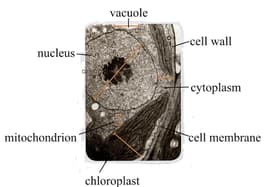Andrew Allott Solutions for Chapter: Cells, Exercise 8: Summative assessment
Andrew Allott Life Sciences Solutions for Exercise - Andrew Allott Solutions for Chapter: Cells, Exercise 8: Summative assessment
Attempt the practice questions on Chapter 2: Cells, Exercise 8: Summative assessment with hints and solutions to strengthen your understanding. MYP Life Sciences A concept based approach Years 1-3 solutions are prepared by Experienced Embibe Experts.
Questions from Andrew Allott Solutions for Chapter: Cells, Exercise 8: Summative assessment with Hints & Solutions
Which cell component releases energy by aerobic respiration?
Which cell component produce oxygen?
Which organisms are made of cells?
What is most likely to happen if a living cell was cut in half?
Which of these parts of the human body are made of cells?
Which of these organisms are made of cells?
Using electron microscopes to research cells
The below photograph was taken using an electron microscope and shows a small part of a plant cell.

Electron microscopes are used to produce magnified images of cell components. The magnification of an image is how much larger it is than the actual structures. Work out the magnification of this photo by following these steps:
a) Use a ruler to measure the diameter of the nucleus in the photo. Do this in millimeters, not centimeters.
b) Convert the diameter in millimeters to micrometers.
c) Divide the diameter of the nucleus in the photo by its actual diameter, . Be sure that both diameters are in micrometers. The value that you have calculated is the magnification of the photo.
Look at the statements given below:
A: After looking at blood using a microscope, people sometimes misunderstand the structure of living organisms and they think that they contain cells.
B. By looking at many different parts of animals and plants we can see that living organisms are made up of cells.
Using scientific language effectively, explain why conclusion A is misleading and how conclusion B supported by evidence.
